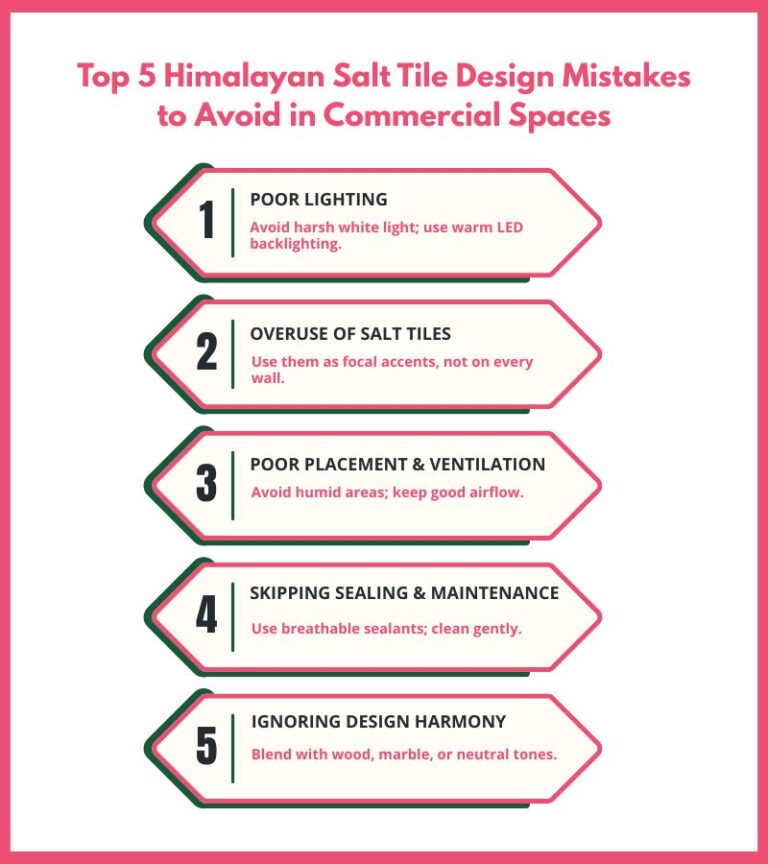Top 5 Design Mistakes to Avoid When Using Himalayan Salt Tiles in Commercial Interiors
- Zayan Rauf

Key takeaways
- Proper lighting can enhance the warm amber glow of Himalayan salt tiles, boosting ambiance and visual comfort in wellness and hospitality interiors.
- Overusing salt tiles across every wall can overpower a space and use them as accent features for balance and aesthetic harmony.
- Maintaining humidity below 60% and ensuring good ventilation prevents salt tile erosion and discoloration.
- Regular sealing and gentle maintenance extend tile life, preserving their natural glow and texture.
- Choosing authentic, high-grade Himalayan salt tiles from trusted suppliers like Sobaan Salts ensures both durability and design quality.
Himalayan salt tiles are becoming a standout feature in modern commercial interiors from luxurious spas and wellness centers to restaurants and hotel lobbies. Their warm amber glow adds a natural, calming charm that promotes relaxation and visual appeal.
However, even the most beautiful salt walls can lose their impact if designed or installed incorrectly. To help you make the most of your investment, here are the top five design mistakes

1. Ignoring the Importance of Proper Lighting
Lighting is what truly brings Himalayan salt tiles to life. When placed under harsh white light, the tiles can look flat and artificial. Too little lighting, on the other hand, hides their natural crystal glow.
Studies show that warm-toned lighting enhances visual comfort and mood in interior environments [1].
Tip: Use warm, dimmable LED backlights to highlight the salt’s natural translucence. This not only enhances ambiance but also gives guests a soothing sensory experience perfect for wellness spaces or hospitality settings.
Read More: Mineral Composition of Himalayan Pink Salt and Its 84 Natural Elements
Did You Know?
Salt-rich building materials can absorb and release up to 1.5 × more moisture at high humidity levels compared to salt-free materials making ventilation and humidity control critical for salt-tile interiors. [6]
2. Overusing Salt Tiles Everywhere
Himalayan salt tiles make a bold statement but using them across every wall can make your space feel overwhelming. Balance and contrast are key design principles [2].
Tip: Choose one focal area such as a reception backdrop, spa relaxation corner, or restaurant feature wall. Combine your Himalayan salt decor ideas with minimalist textures like wood, marble, or matte paint to let the salt truly shine.
3. Poor Placement and Lack of Ventilation
Salt is a natural mineral that absorbs moisture from the air. Installing salt tiles in humid, poorly ventilated areas can cause surface sweating, erosion, and discoloration [3].
Tip: Always install salt walls in climate-controlled environments with humidity below 60%. Avoid direct contact with water or steam sources (like saunas without proper ventilation). This keeps the tiles strong and visually appealing for years.
4. Skipping Sealing and Regular Maintenance
Himalayan salt is porous and fragile. Without proper sealing, the tiles can collect dust or become damaged over time [4]. To ensure long-lasting quality, it’s wise to choose well-crafted, authentic tiles from trusted suppliers like Sobaan Salts, known for producing high-grade Himalayan salt materials ideal for interior applications.
Tip: Use a breathable sealant suitable for natural minerals. Clean the surface gently using a dry microfiber cloth to avoid wet wipes or chemical cleaners. Regular maintenance not only extends tile life but keeps their soft, glowing appearance intact.
Did You Know?
Approximately 20 000–60 000 negative air ions per cm³ have been recorded in salt-mine therapy rooms, significantly higher than typical indoor environments, which may contribute to the calming and air-purifying ambience of salt-based interiors. [7]
5. Ignoring the Overall Design Harmony
A Himalayan salt wall should blend naturally into the overall design not clash with it. Biophilic design experts highlight that harmony between natural textures enhances comfort and occupant well-being [5].
Tip: Pair the pink-orange tones of salt tiles with earthy materials, neutral colors, and soft lighting. This creates a cohesive, relaxing environment that aligns with wellness-inspired interiors.
Read More: How to Use Himalayan Salt Block for Cooking, Grilling & Serving
Conclusion
When thoughtfully designed, Himalayan salt tiles in commercial interiors can turn any space into a warm, wellness-inspired retreat. Avoiding the five mistakes above poor lighting, overuse, bad placement, lack of maintenance, and disharmony will help you achieve both durability and elegance.
At Sobaan Salts, we believe salt decor should balance beauty and function. Whether you’re planning a spa wall, restaurant accent, or office feature, the right design approach will make your Himalayan salt tiles a timeless investment.
References
- Figueiro, M. G., et al. How to use light to promote circadian entrainment and elicit non-visual responses.
- Hosseini, S. N., et al. (2024). An architectural solution to a biological problem: A systematic review of lighting designs in healthcare environments.
- Godts, S., et al. (2023). Salt mixtures in stone weathering.
- Doehne, E. (2002). Salt weathering: A selective review. Getty Conservation Institute
- Kellert, S. R. (2018). Nature by Design: The Practice of Biophilic Design. Yale University Press
- Zhao J., Su J., Bi W. et al. “Hygroscopic properties of salt-containing earthen plasters in the Mogao Grottoes: an experimental study.” npj Heritage Science, 2025.
- Jiang S. Y., Ma A., Ramachandran S. “Negative air ions and their effects on human health and air quality improvement.” International Journal of Molecular Sciences. 2018.
Share This Post
Article By

